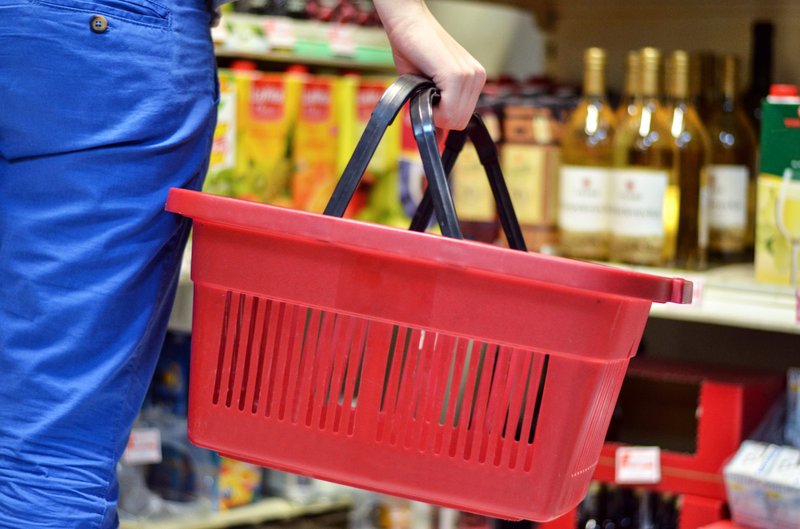Consumer price indices, September 2022
Prices up by 10% annually, down by 0.9% monthly
The biggest impact on annual inflation came from 14.4% higher prices of food and non-alcoholic beverages. Electricity was cheaper by 24.5% and impacted monthly deflation the most, which was the consequence of government interference.
Annual inflation at 10%
The annual growth of prices was 10%, down from 11% in the previous month. The average annual index was 8.4%.
Goods and service prices increased on average by 12.5% and 5.2%, respectively. As regards goods, non-durable goods prices went up by 14.9%, durable goods prices by 10.5%, and semi-durable goods prices by 5.1%.
The greatest impact on annual inflation (2.4 percentage points) came from 14.4% higher prices of food and non-alcoholic beverages. Inflation was raised by 1.6 p.p. by petroleum products (liquid fuel prices increased by 44.1%, diesel prices by 34.8% and petrol prices by 20%). Higher prices of furnishings, household equipment and routine household maintenance (by 13%) contributed to the annual inflation 0.9 p.p. The biggest price increase (by 91.7%) in one year was detected for solid fuels, which impacted inflation by 0.7 p.p.
Deflation at monthly level
In September, consumer prices were on average lower by 0.9% compared to the previous month.
The biggest impact (−1.1 p.p.) on monthly deflation came from 24.5% lower prices of electricity as a result of government interference. This was a result of a change in the tax rate for electricity. Lower prices of package holidays by 14.4% impacted deflation by −0,6 p.p. Operation of personal transport equipment was cheaper by 2.6% and had an impact of −0.3 p.p. −0.1 p.p. each came from lower prices of heat energy (by 7%) and accommodation services (by 5.6 %).
Impact of 0.4 p.p. came from more expensive clothing and footwear (by 6.2%), and 0.2 p.p. each from higher prices of solid fuels (by 14.4%) and food (by 1.3%). 0.1 of impact had more expensive furnishings, household equipment and routine household maintenance (by 0.8%) and miscellaneous goods and services (by 0.7%). All other price increases together contributed 0.1 p.p.
Harmonised indices of consumer prices
Measured with the harmonised index of consumer prices, the annual growth of consumer prices was 10.6% (in September 2021 2.7%). The monthly price growth was −0.3% (previous month −0.1%).
At the annual level, goods prices went up on average by 13% and service prices by 5.9%. As regards goods, non-durable goods prices went up by 16.1%, durable goods prices by 9.1%, and semi-durable goods prices by 5.5%.
Measured with the harmonised index of consumer prices, in August 2022 the annual inflation rate in the EMU countries was 9.1% (up from 8.9% in July). In the EU-27 Member States it was 10.1% (up from 9.8% in July). The lowest annual inflation rate was recorded in France (6.6%) and the highest in Estonia (25.2%); in Slovenia it stood at 11.5%.
The table with the latest data is available in the SiStat Database.
The annual growth of prices was 10%, down from 11% in the previous month. The average annual index was 8.4%.
Goods and service prices increased on average by 12.5% and 5.2%, respectively. As regards goods, non-durable goods prices went up by 14.9%, durable goods prices by 10.5%, and semi-durable goods prices by 5.1%.
The greatest impact on annual inflation (2.4 percentage points) came from 14.4% higher prices of food and non-alcoholic beverages. Inflation was raised by 1.6 p.p. by petroleum products (liquid fuel prices increased by 44.1%, diesel prices by 34.8% and petrol prices by 20%). Higher prices of furnishings, household equipment and routine household maintenance (by 13%) contributed to the annual inflation 0.9 p.p. The biggest price increase (by 91.7%) in one year was detected for solid fuels, which impacted inflation by 0.7 p.p.
Deflation at monthly level
In September, consumer prices were on average lower by 0.9% compared to the previous month.
The biggest impact (−1.1 p.p.) on monthly deflation came from 24.5% lower prices of electricity as a result of government interference. This was a result of a change in the tax rate for electricity. Lower prices of package holidays by 14.4% impacted deflation by −0,6 p.p. Operation of personal transport equipment was cheaper by 2.6% and had an impact of −0.3 p.p. −0.1 p.p. each came from lower prices of heat energy (by 7%) and accommodation services (by 5.6 %).
Impact of 0.4 p.p. came from more expensive clothing and footwear (by 6.2%), and 0.2 p.p. each from higher prices of solid fuels (by 14.4%) and food (by 1.3%). 0.1 of impact had more expensive furnishings, household equipment and routine household maintenance (by 0.8%) and miscellaneous goods and services (by 0.7%). All other price increases together contributed 0.1 p.p.
Harmonised indices of consumer prices
Measured with the harmonised index of consumer prices, the annual growth of consumer prices was 10.6% (in September 2021 2.7%). The monthly price growth was −0.3% (previous month −0.1%).
At the annual level, goods prices went up on average by 13% and service prices by 5.9%. As regards goods, non-durable goods prices went up by 16.1%, durable goods prices by 9.1%, and semi-durable goods prices by 5.5%.
Measured with the harmonised index of consumer prices, in August 2022 the annual inflation rate in the EMU countries was 9.1% (up from 8.9% in July). In the EU-27 Member States it was 10.1% (up from 9.8% in July). The lowest annual inflation rate was recorded in France (6.6%) and the highest in Estonia (25.2%); in Slovenia it stood at 11.5%.
The table with the latest data is available in the SiStat Database.
Annual growth rates of consumer prices, Slovenia
Consumer price indices, Slovenia
|
Growth rates of harmonised consumer prices, Slovenia
1) Indices. |
When making use of the data and information of the Statistical Office of the Republic of Slovenia, always add: "Source: SURS". More: Copyright.


.jpg)
.jpg)
